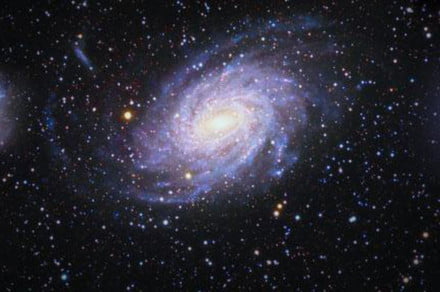Left to right: the Large Magellanic Cloud, the Milky Way Galaxy, and Antlia 2. V. Belokurov / Marcus and Gail Davies / Robert Gendler.
New research suggests that hundreds of millions of years ago the Milky Way collided with Antlia 2, a nearby dwarf galaxy. This collision caused ripples in the edge of the disk of gas around the Milky Way which we still observe today.
Antlia 2 is about one third the size of the Milky Way, and is believed to be the galaxy dominated by dark matter which astronomers predicted to exist back in 2009. Its location matches the predictions but it was only discovered in 2018 because it has very low density and gives off very little light.
The new data shows that based on Antlia 2’s trajectory, it would have collided with the Milky Way and caused the ripples in its gas disk.
“The discovery could help develop methods to hunt for dark galaxies and ultimately solve the long-standing puzzle of what dark matter is,” astrophysicist Sukanya Chakrabarti, lead author of the study, said in a statement.
Dark matter is a type of subatomic particle which is theorized to exist in order to explain the mass of galaxies. Given the way that galaxies move and interact, scientists believe they must be heavier than the amount of regular matter within them would suggest. They created the theoretical dark matter particle to explain where all this extra mass comes from.
But despite many experimental attempts to locate dark matter, such a particle has never been observed. Instead, researchers rely on indirect evidence of dark matter such as observing the distribution of starlight within galaxy clusters.
“We don’t understand what the nature of the dark matter particle is, but if you believe you know how much dark matter there is, then what’s left undetermined is the variation of density with radius,” Chakrabarti explained in the statement.
“If Antlia 2 is the dwarf galaxy we predicted, you know what its orbit had to be. You know it had to come close to the galactic disc. That sets stringent constraints, therefore, on not just on the mass, but also its density profile. That means that ultimately you could use Antlia 2 as a unique laboratory to learn about the nature of dark matter.”
The paper is available on pre-publication archive arXiv and will be published in the journal Astrophysical Journal Letters.
Editors’ Recommendations
- This galaxy, Messier 90, appears blue because it’s traveling toward us
- Step into the center of the galaxy with NASA’s 360-degree visualization
- The earliest galaxies shone brightly in the young universe
- How Google Stadia and game streaming services will hurt game creators
- Google’s Stadia is the future of gaming, and that’s bad news for our planet

